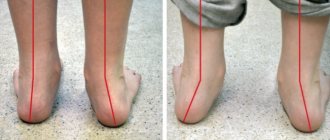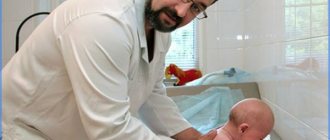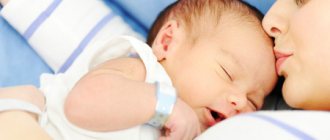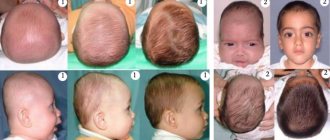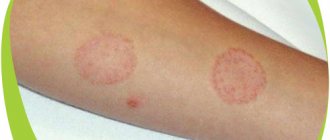As the great F. Nietzsche said: “When you want to rise up, rely on your own legs.” But what to do if you want to get up, you have legs, but the person has them like wheels. What is this pathology called? And is it possible to fix this? Today we will talk about Genu Varum.
Varus deformity (Genu Varum or O-shaped deformity) is a type of deformity of the knee or hip joints, in which the knees diverge in different directions, while the person’s feet remain closed. In such situations, a gap appears between the legs, resembling the letter “O”. People suffering from this disease are commonly referred to as having a “wheel” or varus.
WHAT REALLY IS VARUS?
Varus is the medical term used to describe deformities in which a person's forefoot is displaced inward. A similar picture can occur not only in childhood, but often in adults. As a rule, this pathological condition affects not only the feet; sometimes negative changes can reach the knees and even the hips. In such situations, the femur becomes skewed, with the outer part becoming unnecessarily enlarged. The lower leg becomes convex and this visual tubercle turns outward. The heels, like the entire foot, are correspondingly bent inward. This pathology is quite common. Normally, it is observed in children under 24 months of age. If in a small child the problem was not detected in a timely manner, then in adulthood he may have the problem of forced noticeable limited mobility. This usually occurs due to prolonged uneven work under loads such as walking, running, and other axial loads, while excessive impact increases on some ligaments and muscles, and leads to unnecessary stretching of others. Along with the physical suffering of the child or adult, in such cases an aesthetic defect also appears - the legs visually look like a “wheel”.
Causes of foot deformities
The causes of hallux valgus in the feet are as follows:
- hereditary factor;
- transverse flatfoot;
- some endocrine pathologies;
- osteoporosis.
Women suffer from hallux valgus five times more often than men. This is due to the congenital weakness of the bone tissue of the feet, as well as the fact that many ladies prefer high-heeled shoes.
Varus deformity
may occur due to the following reasons:
- rickets and other metabolic disorders that reduce bone density;
- genetic predisposition;
- flat feet; foot injuries;
- wearing uncomfortable tight shoes for a long time.
Varus pathology occurs more often in children, but at an early age it is easier to get rid of. Degrees of foot deformation
When hallux valgus occurs, the actual degree of the disease is determined based on the size of the angle formed between the big toe and the metatarsal bone. There are three degrees of valgus pathology:
- first: directly in the intermetatarsal angle, there is an increase in joint deformation, while the ligaments are excessively mobile, and subluxation of the foot occurs;
- second: the displacement of the joints and the nearest tendons in the area of the thumb is diagnosed;
- third: both bone and almost all connective tissue become very weak and vulnerable, which is accompanied by constant pain in the affected area.
Varus deformity is also divided into three degrees:
- light: supination and deformation of the foot do not exceed 10-15 degrees, the foot can be brought to its normal position;
- medium: the equinus angle ranges from 15 to 30 degrees, but the clubfoot components can still be corrected;
- severe: the equinus angle exceeds 30 degrees, the deformity becomes stable and can only be partially corrected.
Preventing diseases with orthopedic insoles
Orthopedic insoles are excellent for treating foot deformities. They allow not only to increase the level of comfort when walking and minimize pain, but also to stop the development of the disease. The process of choosing therapeutic insoles should be approached especially carefully. First of all, you should take into account the type of disease that requires orthopedic correction. An important factor is the degree of manifestation of the disease.
For hallux valgus pathology, the following types of insoles are recommended:
- therapeutic, intended to correct a deformed arch of the foot. Such products have a fairly rigid shape and cover the foot well in order to maintain the required position of all cartilages. Recommended for use with orthopedic shoes;
- preventive – used in the initial stages of hallux valgus. They can be worn with regular shoes;
- therapeutic and prophylactic - they are made of leather or special elastic fabric. The products are slightly springy and do not compress the foot too tightly. Such insoles can be shortened in design and used with any shoes
Based on their functional qualities, orthopedic insoles used for hallux valgus are divided into several types:
- arch-supporting – significantly reduce the load on the feet, minimize pain;
- arch-forming – designed to ensure the smoothest possible roll of the arch. Often used in pediatric orthopedics to correct flat feet;
- unloading – provide a uniform load on the entire foot; for this purpose they have special bulges and indentations;
- therapeutic – designed to correct the incorrect position of the feet, equipped with additional elements: instep supports, pelotas, high sides.
In addition to full-size orthopedic products, there are also half-insoles that do not have a front part.
Such devices also have therapeutic and prophylactic properties. Their main advantage over conventional insoles is that there is no need to select the product by size. In addition, half-insoles can be worn even with the most open shoes, because they will not be visible from the outside. In some cases, wearing heel pads or heel pads, which are small orthopedic devices designed to solve local orthopedic problems, may be indicated. Such products are recommended for heel spurs, as well as for use in shoes with an excessively hard heel. Insoles for pes varus are designed to rotate the entire foot, including the heel, into the correct position. For this purpose, special antivarus insoles are used, which have special thickenings on the outer heel part - pronators. This design allows you to give the foot the desired shape. How to choose orthopedic insoles
When deciding how to choose insoles for hallux valgus, you should consider the most important recommendations:
- pay attention to the size of the insoles, having first measured the length of your foot in centimeters. To determine the length of the foot, place it on a sheet of paper and carefully trace the contours with a ballpoint pen. After this, you need to draw a line on the sheet using a ruler in the place where the length of the drawing is maximum, and measure it. This will be the desired size indicator;
- if there are doubts about the accuracy of determining the size of the foot, it is better to choose products that have double or triple sizes, which allows you to avoid mistakes in purchasing insoles;
- some insoles are designed so that they can be trimmed - in this case, you can purchase a slightly larger size than the actual length of the foot;
- for women who still do not want to give up wearing shoes with heels, you should select products made of leather, cork and special foam; if a person’s weight exceeds 100 kg, it is better to give preference to graphite or hard plastic insoles;
- For diabetes, double-layer insoles are recommended. In addition to the therapeutic orthopedic effect, such products prevent the appearance of calluses and open wounds, which are dangerous in this endocrine pathology;
- for planovalgus deformity, leather or felt insoles with an orthopedic effect are well suited;
- workers who have to stand still for a long time (hairdressers, salesmen, etc.) are recommended to use rigid, preferably framed, orthopedic products; athletes are shown frameless insoles; children with hallux valgus are suitable for thermoplastic insoles, as well as products with instep supports and other unloading elements. It is better to agree on the final version of insoles with your doctor.
Advantages and effectiveness of using orthopedic insoles
Provided the correct selection of insoles and their regular use, the effect of treatment will definitely manifest itself. The most important benefits and positive changes are:
- the arch of the foot is fixed, therefore its further deformation in case of hallux valgus pathology slows down and even completely stops;
- pathologically changed small joints of the feet gradually return to the correct position;
- deformed and excessively curved toes gradually straighten and take on the correct shape, which is especially important for hallux valgus;
- the load on the soles of the feet becomes more uniform, due to which calluses, corns and other compactions disappear;
- harm from incorrectly selected or excessively hard shoes is minimized provided that shock-absorbing insoles are used;
- pain when walking is eliminated due to the reduced load on the feet and the springy properties of orthopedic products;
- venous blood flow in the legs improves, therefore swelling of the feet decreases.
The benefits of wearing orthopedic products will be even more noticeable if insoles for hallux valgus or varus pathology are selected after consulting with a doctor. The specialist will recommend the most optimal option for therapeutic shoe inserts for the individual patient, which will help speed up recovery.
Features of choosing children's orthopedic insoles
It is for children that an individual and careful choice of insoles is of decisive importance, because in this case parents are faced with an important task - to quickly stop the process of deformation of the joints in the foot area, to save the child from manifestations of flat feet or other orthopedic disorders.
For varus deformity, which is most common in children, orthopedic insoles without any instep supports are recommended. These corrective inserts can be combined with special shoes with pointed toes. It is advisable to order children's orthopedic insoles individually if hallux valgus is diagnosed. In the heel area of the product there should be a special recess, the contours and depth of which must be determined by the doctor.
The specialist also selects the height of the instep support, which should be located exactly under the inner arch of the foot. Even after the symptoms of foot deformation disappear, it is advisable to use therapeutic and prophylactic insoles until the child reaches the age of 14-16 years.
Tips for choosing shoes that enhance the effect of orthotics
To maximize the effect of therapeutic insoles, shoes should be:
- with a fairly wide heel of low height (up to 4-5 cm). Shoes with completely flat soles are not permitted;
- It is desirable that shoes, even summer ones, have a high, stable heel;
- the toe part of the shoes or boots should be quite wide, not squeezing the toes.
If you can remove the factory insoles from your shoes, it is best to do so before using orthotics. Otherwise, corrective devices should be placed on top of the “original” shoe insoles.
WHAT CURVATION OF THE LINKS IS CONSIDERED NORMAL IN NEWBORNS?
As a rule, normally, almost all newborn babies may experience a slight arched curvature of the legs (up to 20 degrees), due to the intrauterine position of the fetus. In this case, the child’s legs are symmetrical, but the shape and position of the feet may be asymmetrical. By the age of two, the O-shaped deformity disappears and is gradually replaced by an X-shaped (valgus) one. A slight valgus curvature of the legs (up to 15 degrees) sometimes persists for up to 3 years, and then begins to decrease, and by about 8 years it does not exceed 7-9 degrees. Subsequently, both the complete disappearance of the curvature and the preservation of a slight residual angle are possible. Varus curvature, which persists at the age of 2 years and older, is the cause of abnormal development of the knee joints, which subsequently leads to the formation of compensatory planovalgus deformity of the feet.
Treatment methods
This is a whole complex of procedures that have a cumulative effect. Treatment is a long process that can take years. And no modern methods can qualitatively speed up the result.
Therefore, we clarified that it is so important to diagnose the pathology as early as possible. After all, considering how much time you will have to spend on treatment, it is better to start in advance. And every day, while the child does not use his musculoskeletal system correctly, the situation worsens. The diagnosis must be made by an orthopedic surgeon. And for subsequent procedures and appointments, it is important to choose the most professional specialist. People make mistakes, and the cost of making mistakes in this industry is too high. Therefore, this is exactly the case when it is better to spend resources on choosing the best performer.
Focus on the immediate results only by five years. Previously, qualitative changes will not be noticeable. After all, the musculoskeletal system itself fully develops just in time for this period. And it is then that we can draw conclusions about whether the treatment is successful.
Remember that traditional medicine methods are strictly excluded. In principle, they cannot be considered effective. In some areas, doctors look at the use of traditional medicine carelessly. Like, what’s wrong if you use grandma’s broth to treat a runny nose? But from this perspective, traditional medicine can bring the most unfavorable consequences.
If clubfoot equinovarus is treated with traditional methods, they may well completely block the symptoms for some period of time. And also reduce the possible pain effect. As a result, the patient will not complain, the problem will begin to be ignored. But incorrect load, abnormal position of the foot, deformation of bone tissue, decreased muscle tone - all this will remain. And the problem will grow and worsen day by day. And the moment will come when it will no longer be possible to ignore it, but then modern classical medicine will hardly be able to demonstrate impressive results. The case will be too neglected.
After diagnosis, the first thing you will have to deal with is the referral for tests and examinations. This:
- Radiography.
- General blood and urine analysis.
- In some cases, magnetic resonance imaging is prescribed.
Next, a set of medical procedures is prescribed, which show effectiveness only when used together. Therefore, you should not exclude any of the procedures because of inconvenience or because the child does not like them. Think about his future health. So, the assignments could be as follows:
- Physiotherapy. Various techniques have been successfully used in this area. Laser therapies, thermal, and magnetic are reflected. But in this case, they are still of an auxiliary nature rather than being the main one for treatment.
- Exercise therapy. That is, physical therapy. It is worth noting that the complex is selected strictly according to the direction of the treating orthopedist. Classes are held in special centers. Further, after a little training, you can continue training at home. But parents must strictly go through the learning process and understand all the features of the baby’s physiology. Carefully study which exercises contribute to development, and which, on the contrary, can only aggravate the situation. Often, many parents continue to attend classes so that the process proceeds under the watchful supervision of the instructor.
- Massage. This is already one of the basic elements. And it is used at almost all stages. High-quality services of a massage therapist with specialized education are often paid. Moreover, a specialist is usually called to your home. Several times a week he visits the baby, massages him, kneads the ankle, and helps increase mobility and proper fixation.
The last method, which is considered the most successful, is the selection of specialized orthopedic shoes. It helps to fix the position of the foot, which ensures the reverse deviation process. Constantly wearing shoes and insoles is a painless method to correct the situation. But here a lot depends on the selling company.
Our project is pleased to offer you orthopedic shoes and insoles. If your child has equinovarus feet ICD 10 Q66, then we will easily select a suitable product for you. The Ortopanda online store works with various prescriptions from the attending physician and has a wide range of products that will satisfy the requirements for any stage and form of pathology. Even if we are talking about rare deviations, we will always be able to select specific shoes that solve exactly this problem.
WHAT ARE THE CONSEQUENCES OF VARUS DEFORMITY OF THE LOWER LIMB?
Varus deformity of the legs is a disease that requires constant monitoring and treatment. Ignoring treatment leads to a violation of the distribution of body weight on the legs, a deviation of the center of gravity, which will significantly affect a person’s gait. Along with the development of pathology, severe pain in the legs often occurs, flat feet intensify, pronounced cosmetic defects often appear, and a person has problems choosing shoes. In the future, very often this leads to disability of the patient.
Exercises for feet with varus and valgus deformity
If you have varus deformity, the following exercises are recommended:
- flexion and subsequent extension of the feet - perform 20 times for each foot;
- rotating the feet in a circle – also 20 times;
- supported squats: you need to squat while holding onto a support, making sure that your feet remain pressed to the floor
Hallux valgus deformity is corrected faster thanks to the following exercises:
- walking alternately: on the outside, then on the inside of the feet;
- alternately walking on your toes, then on your heels;
- walking on lumpy, uneven surfaces barefoot. You can walk on a massage mat, an ordinary carpet, on the sand on the beach, on the grass in nature;
- grabbing small objects on the floor with your toes. You can lay out buttons, ballpoint pens, pencils on the surface, and then try to grab and lift them with your fingers;
- climbing and descending the wall bars is an excellent exercise for hallux valgus.
Performing these exercises, as well as using such a wonderful device as orthopedic valgus insoles, will minimize pain and speed up recovery from foot deformities. A foot massage can also be of great benefit to the patient, which can be performed independently, but better - with the help of another person. With the help of massage movements, you can increase blood flow, eliminate muscle tension in the legs, and give the toes the correct position. Comprehensive treatment using orthopedic devices and high-quality shoes will speed up recovery, which is especially important for children and adolescents.
Buy better quality orthopedic insoles for hallux valgus from well-known manufacturers. Branded products will last longer, and the effect of their use will be more noticeable. With timely correction of orthopedic disorders, you can quickly achieve a positive result and maintain the health of yourself or your child.
WHAT ARE THERE METHODS FOR TREATING VARUS LEG DEFORMITY?
Treatment for varus deformity is selected by an orthopedic surgeon based on the degree of deformation of the limbs and a detailed study of the reasons that led to this. Also, at the diagnostic stage, false curvature of the legs must be excluded, i.e., one in which there are no disorders in the skeletal system, and the problem lies only in the muscles of the legs. The main methods of treatment at the initial stage of the disease are:
- wearing corrective products;
- providing massage therapy;
- a set of special exercises;
- physiotherapy.
If excess weight is noted against the background of deformation, the patient also necessarily needs diet therapy. If the above methods do not help, the patient undergoes surgery.
Equino varus feet, features of the disease
The main distinguishing feature is the fact that as the deformity develops, the natural position of the leg is disrupted. Accordingly, this leads to a lot of logically expected consequences:
- Incorrect load. This impairs the correct development of the legs, the musculoskeletal system and the entire body as a whole.
- Muscle tone is impaired. And some of them are in constant tension, which should not happen, while the other part, on the contrary, atrophies. After all, they are not fully utilized.
- Constant pressure on bone tissue. Due to the load, which is essentially not planned by nature. And as a result, the bone itself also begins to deform.
